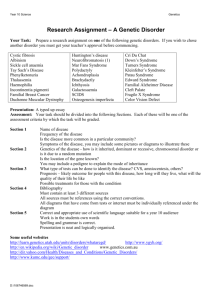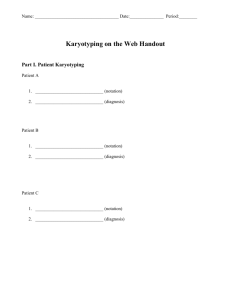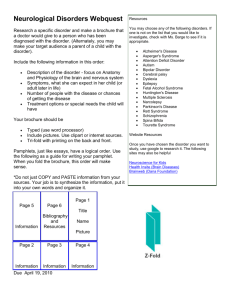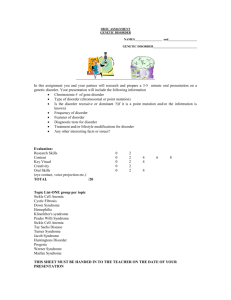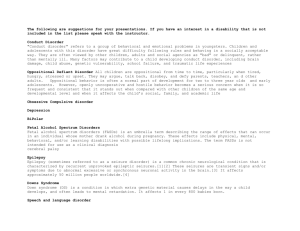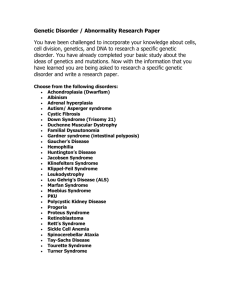Genetic/Chromosomal Disorders
advertisement
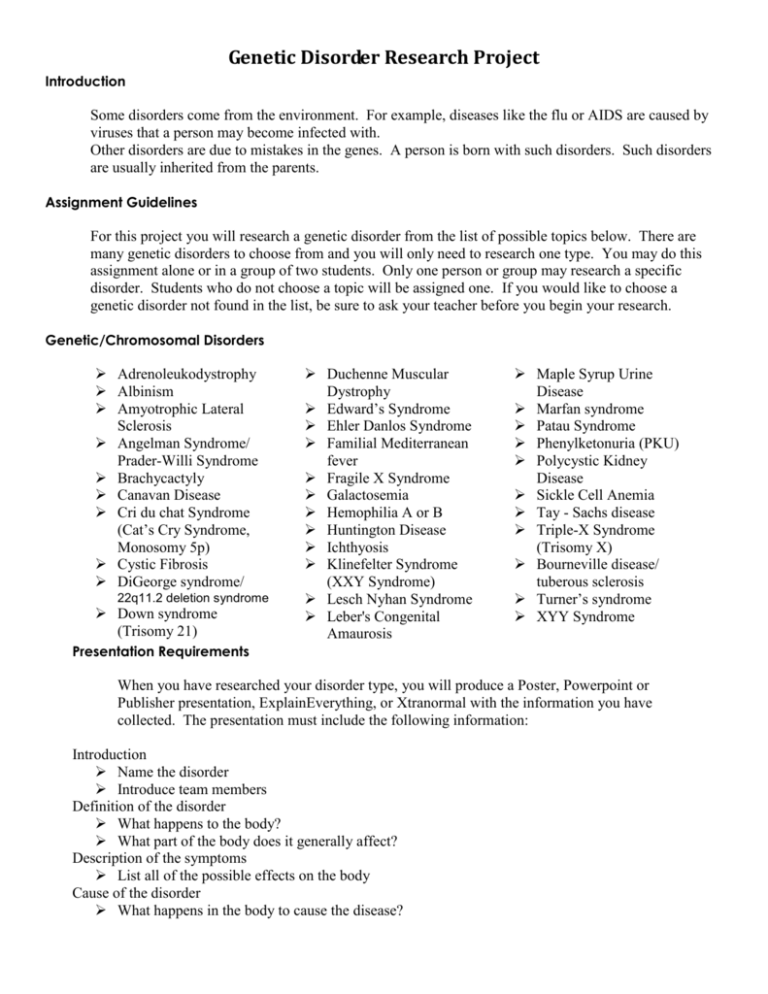
Genetic Disorder Research Project Introduction Some disorders come from the environment. For example, diseases like the flu or AIDS are caused by viruses that a person may become infected with. Other disorders are due to mistakes in the genes. A person is born with such disorders. Such disorders are usually inherited from the parents. Assignment Guidelines For this project you will research a genetic disorder from the list of possible topics below. There are many genetic disorders to choose from and you will only need to research one type. You may do this assignment alone or in a group of two students. Only one person or group may research a specific disorder. Students who do not choose a topic will be assigned one. If you would like to choose a genetic disorder not found in the list, be sure to ask your teacher before you begin your research. Genetic/Chromosomal Disorders Adrenoleukodystrophy Albinism Amyotrophic Lateral Sclerosis Angelman Syndrome/ Prader-Willi Syndrome Brachycactyly Canavan Disease Cri du chat Syndrome (Cat’s Cry Syndrome, Monosomy 5p) Cystic Fibrosis DiGeorge syndrome/ 22q11.2 deletion syndrome Down syndrome (Trisomy 21) Duchenne Muscular Dystrophy Edward’s Syndrome Ehler Danlos Syndrome Familial Mediterranean fever Fragile X Syndrome Galactosemia Hemophilia A or B Huntington Disease Ichthyosis Klinefelter Syndrome (XXY Syndrome) Lesch Nyhan Syndrome Leber's Congenital Amaurosis Maple Syrup Urine Disease Marfan syndrome Patau Syndrome Phenylketonuria (PKU) Polycystic Kidney Disease Sickle Cell Anemia Tay - Sachs disease Triple-X Syndrome (Trisomy X) Bourneville disease/ tuberous sclerosis Turner’s syndrome XYY Syndrome Presentation Requirements When you have researched your disorder type, you will produce a Poster, Powerpoint or Publisher presentation, ExplainEverything, or Xtranormal with the information you have collected. The presentation must include the following information: Introduction Name the disorder Introduce team members Definition of the disorder What happens to the body? What part of the body does it generally affect? Description of the symptoms List all of the possible effects on the body Cause of the disorder What happens in the body to cause the disease? Is it a mutation? A genetic tendency triggered by other factors? How the disorder is inherited Is it sex-linked? Is there a particular chromosome it is located on? Is it recessive or dominant? Make a drawing of how the disorder is inherited (Either a Punnette square or pedigree) How the disorder is treated Medications? Gene therapy? How the disorder is diagnosed What tests are done? Is genetic counseling an option? How many and what type of people are likely to have the disorder Is it more common in a certain group of people? How common is it? Cultural Relevancy Are there any famous people, or their family members, who have the disease? Does it show up on TV or the movies? Any superstitions regarding the disease? Application of research article What new information did you learn from your research? Useful Resources http://gslc.genetics.utah.edu/ The Genetic Science Learning Center is a useful source to obtain information on genetic disorders. http://www.ncbi.nlm.nih.gov/pubmedhealth/s/diseases_and_conditions/a/ A comprehensive library of human diseases. National Human Genome Research Institute (NHGRI) This site from a National Institutes of Health affiliate provides information on genetics, inherited disease research, genetics and rare diseases, online resources, and the ethical, legal, and social issues related to genetic research. Grading Rubric A Introduction Definition Symptoms Cause Inheritance Treatment Diagnosis How many and what type of people are likely to have the disorder Application of research article Attractiveness/ Presentation B C D Title can be read from 4 ft. away and describes the content. Includes group members. The title is too small and/or does not describe the content of the poster well. Answers each topic indepth with details and examples. Subject knowledge is excellent. Answers each topic indepth with details and examples. Subject knowledge is excellent. Answers each topic indepth with details and examples. Subject knowledge is excellent. Answers each topic indepth with details and examples. Subject knowledge is excellent. Answers each topic indepth with details and examples. Subject knowledge is excellent. Answers each topic indepth with details and examples. Subject knowledge is excellent. Answers each topic indepth with details and examples. Subject knowledge is excellent. Covers topic in-depth with details and examples. Subject knowledge is excellent. Title can be read from 6 ft. away and describes content well. Includes group members. Answers essential information about topic. Subject knowledge appears to be good. Answers essential information about topic. Subject knowledge appears to be good. Answers essential information about topic. Subject knowledge appears to be good. Answers essential information about topic. Subject knowledge appears to be good. Answers essential information about topic. Subject knowledge appears to be good. Answers essential information about topic. Subject knowledge appears to be good. Answers essential information about topic. Subject knowledge appears to be good. Includes essential knowledge about the topic. Subject knowledge appears to be good. Includes essential information about the topic but there are some factual errors. Content is minimal OR there are several factual errors. Includes essential information about the topic but there are some factual errors. Content is minimal OR there are several factual errors. Includes essential information about the topic but there are some factual errors. Content is minimal OR there are several factual errors. Includes essential information about the topic but there are some factual errors. Content is minimal OR there are several factual errors. Includes essential information about the topic but there are some factual errors. Content is minimal OR there are several factual errors. Includes essential information about the topic but there are some factual errors. Content is minimal OR there are several factual errors. Includes essential information about the topic but there are some factual errors. Content is minimal OR there are several factual errors. Includes essential information about the topic but there are 1-2 factual errors. Content is minimal OR there are several factual errors. The presentation is exceptionally attractive in terms of design, layout, and neatness. The presentation is attractive in terms of design, layout and neatness The presentation is acceptably attractive though it may be a bit messy. The presentation is distractingly messy or very poorly designed. It is not attractive. Title can be read from 6 ft. away and is quite creative. Includes group members. Due Date: ___January 15, 2014_____ Genetic Disorder: ________________________________ Presentation Requirements Earned Points Possible Points Introduction Definition of the disorder Description of the symptoms Cause of the disorder How the disorder is inherited How the disorder is treated How the disorder is diagnosed How many and what type of people are likely to have the disorder 5 5 5 10 20 5 5 8 Cultural Relevancy 2 Application of research article Attractiveness/Presentation Makes excellent use of font, color, graphics, effects, etc. to enhance the presentation. Personal Presentation o If you do not present in front of the class this will be reflected in extra attention to detail on poster/extranormal/powerpoint Total Points Earned 5 5 5 80
